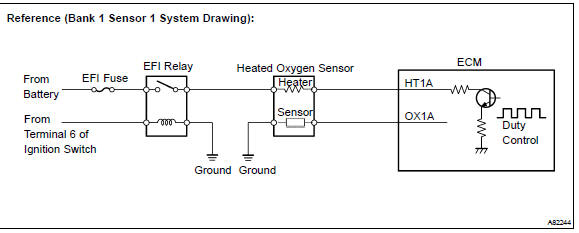Toyota Corolla (E120) 2002–2008 Repair Manual / Diagnostics / Sfi system / Oxygen sensor heater control
circuit... / Circuit description
Toyota Corolla (E120): Circuit description
Refer to dtc p0130
Hint
: the ecm provides a pulse width modulated control circuit to adjust current through the heater. The heated oxygen sensor heater circuit uses a relay on the b+ side of the circuit.


Monitor description
The ecm uses the heated oxygen sensor information to regulate the air–fuel ratio close to a stoichiometric ratio. This maximizes the catalytic converter’s ability to purify the exhaust gas. The sensor detects oxygen levels in the exhaust gas and sends this signal to the ecm.
The inner surface of the sensor element is exposed to the outside air. The outer surface of the sensor element is exposed to the exhaust gas. The sensor element is made of the platinum coated zirconia and includes an integrated heating element. The heated oxygen sensor has the characteristic whereby its output voltage change suddenly in the vicinity of the stoichiometric air–fuel ratio. When heated, the sensor becomes very efficient. If the temperature of the exhaust is low, the sensor will not generate useful voltage signals without supplemental heating. The ecm regulates the supplemental heating using a duty–cycle approach to regulate the average current in the heater element. If the heater current is out of the normal range, the sensor’s output signals will be inaccurate and the ecm cannot regulate the air–fuel ratio properly. When the heater current is out of the normal operating range, the ecm interprets this as a malfunction and sets a dtc.
Example: the ecm will set a high current dtc if the current in the sensor is more than 2 a when the heater is off.
Similarly, the ecm will set a low current dtc if the current is less than 0.25 A when the heater is on.
Monitor strategy

Typical enabling conditions

Typical malfunction thresholds

Component operating range

Monitor result (mode 06 data)

Refer to page 05–27 for detailed information on checking monitor status.
Wiring diagram
Refer to dtc p0130
Other materials:
Location of the spare tire, jack and tools
1 Luggage floor cover
2 Wheel nut wrench
3 Jack handle
4 Jack attachment*
5 Jack
6 Spare tire
7 Tool tray
*: The jack attachment is used when raising your vehicle with a floor jack.
CAUTION
■Using the tire jack
Observe the following precautions.
Improper use of the tire jack may c ...
Riding with children
Observe the following precautions
when children are
in the vehicle.
Use a child restraint system
appropriate for the child,
until the child becomes
large enough to properly
wear the vehicle's seat belt.
It is recommended that children
sit in the rear seats to
avoid accidental contact
with the ...
Fog light switch
The fog lights secure excellent visibility in difficult driving conditions,
such as in rain and fog.
1 Turns the front fog lights off
2 Turns the front fog lights on
*1: For U.S.A.
*2: For Canada
■Fog lights can be used when
The headlights are on in low beam. ...


